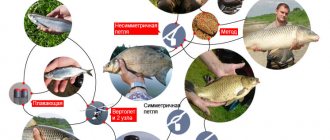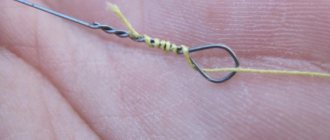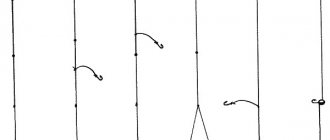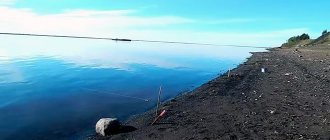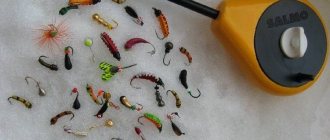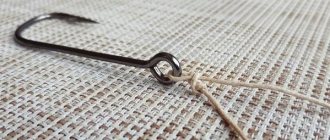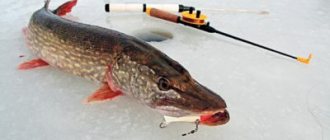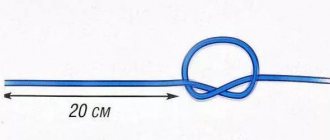Greetings, dear fishing enthusiasts. In today's article we will understand how to attach a leash to fishing equipment. The use of this element is an integral part of any fishing method, be it a feeder, a spinning rod, or a regular float.
In spinning, leashes are used when fishing for pike, when jigging, as well as in diverting rigs (Moscow, Carolina, Texas, etc.). Fishing with a feeder and float is generally not possible without the use of a leash.
First, let's look at all the possible options for connecting the leash and fishing line, and then go over the fishing methods.
Connection methods pros and cons
In the fishing world, there are 3 ways to attach a leash:
- Loop-to-loop method
- Blind knot
- With additional accessories
The loop-to-loop method is quite simple and is used in all fishing methods. Its advantages are simplicity and speed of connection. The disadvantage is that it is unstable to the current (the leash gets twisted), bulky and difficult to disconnect.
The blind knot is more compact, which results in less debris (grass) sticking to the line, and as a result, an increase in the number of bites. The disadvantages are the low knitting speed, instability to the current, and the difficulty of replacing the leash.
The fittings are the most convenient solution. By accessories, I mean various carabiners, swivels, fasteners, etc. The advantages include ease of installation, and the disadvantages are cumbersomeness.
Now let's figure out what these connections are and how to use them, and first we'll look at the most common method.
Loop-to-loop connection
This method is used in absolutely all types of fishing. This popularity is due to the ease of installation and at the same time maximum strength.
Knitting loops
There are several types of loops, here we will look at the simplest and most popular way of knitting loops.
- Fold the fishing line in half
- We make a regular knot by threading the line 3 times
- Tighten and the knot is ready
Connecting the leash and fishing line
Now we need to connect our pieces of equipment, and there are two options here. Both methods are a loop-to-loop connection, there is no difference in strength, but one method is well suited for connecting with braid, and the second for two lines.
First, let's look at the method for braiding ( the leash is also connected to the swivel ), here you need to thread the leash into the loop of the braid (swivel), and thread the hook into the loop of the leash:
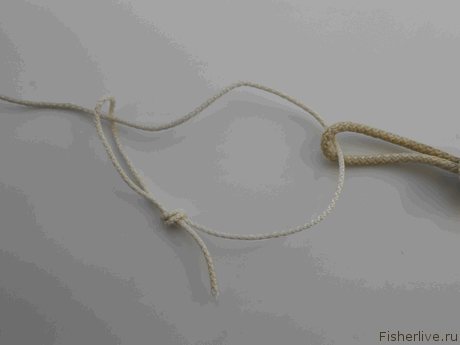
This type of connection is very simple, but when used on monofilament, it gets tangled (due to its rigidity), so at the end of fishing you often have to cut the leash.
The second method can be used anywhere; it is universal, but if the loops are small, you will have to spend time on installation. First, we thread the loop of the main line into the loop of the leash:
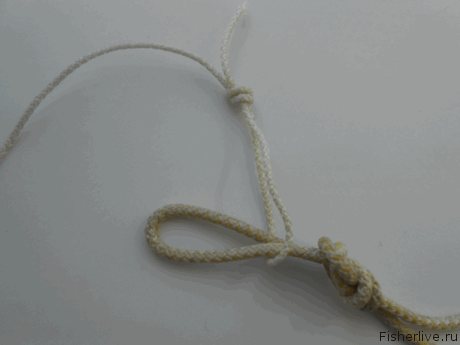
Now we thread the hook into the loop of the main fishing line:
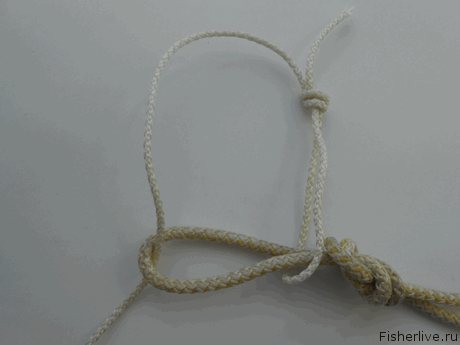
Tighten and get this connection:

This method distributes the load evenly, which ensures free removal of the leash after fishing.
Characteristics
Under this heading we will consider various characteristics of connections and nodes.
- Strength retention: 90% (if the fishing line can withstand 1 kilogram, then the knot will withstand 900 grams)
- Line difference: Infinite (the ratio of line diameters does not affect strength)
- Visibility in water: 60% (quite noticeable compound)
- Connection speed: 40% (first you need to tie the loops, and this takes time)
Use of swivels, carabiners, and clasps
This fittings are also used in all fishing methods, and any angler can use them, but we’ll talk about the application below, and now we’ll figure out how to attach swivels and other elements to the fishing line.
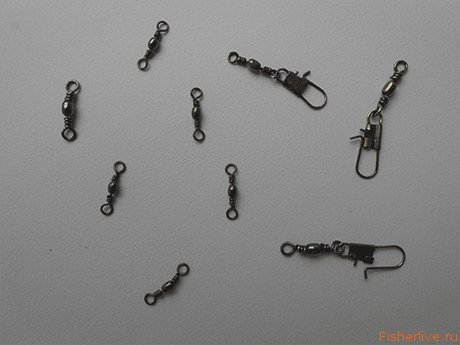
They are knitted with ordinary fishing knots; any knot will do, for example the one with which you tie the hooks. I knit like this:

- We thread the fishing line through the loop of the carabiner
- We make 6-7 turns with the short end of the fishing line around the long one
- We pass the short end of the fishing line into the formed loop
- We wet, tighten and get a finished knot
This knot is suitable for both monofilament and braided fishing line, only on braided it is more difficult to tighten; it must be moistened with saliva. You can also connect the fishing line with the swivel using the “loop to loop” method, which we discussed above.
A “correctly” tied leash is a flexible concept
If we consider the node connection itself, then everything is clear and without options:
- The leash must be tied securely so that it can withstand the resistance of the bait and the jerks of the fish.
- The knot should be small, pass through the passage rings of a fishing rod or spinning rod without interference, and should not catch water debris when fishing.
- Sometimes it is necessary to tie the leash to the fishing line at 90 degrees, so the knot must maintain its position and “hold” the direction of installation.
When a fisherman believes that a correctly tied leash means strict adherence to the length of the lead segment, its clear location at a given point in relation to other elements of the equipment (sinker, second leash), then everything is somewhat “unstable”.
The length of the leashes has to be selected according to the fishing conditions and the activity of the fish directly during fishing. Of course, within reasonable limits.
Their location on the main line is also adjusted according to the conditions. For example, in the presence of dense and tall vegetation at the bottom of a reservoir. The fish takes the bait slightly above the grass carpet, at half-water, and the equipment must be held at a given point with a heavy load. Naturally, you have to move the leash along the main line higher, towards the fish.
Yes, there are many different nuances. Therefore, a “properly tied leash” is one that ensures reliability and bite. And all this is selected through trial and error.
But this is a normal course of events; fishing is a creative activity. And now, as one movie character said, closer to the body.
Let's start with the simplest method.
The use of compounds depending on the fishing method
Now we come to the most interesting part, that is, we will figure out where, how and why to use this or that connection of the leash with the main fishing line.
Spinning
In a spinning rod, depending on the fishing method, the nature of the bottom, and the casting distance, all connection options can be used.
For example, when fishing with a retractable leash, the loop-to-loop method or fittings are used; you can learn more about this method of fishing at LINK.
If you need to tie a fluorocarbon leash to the main fishing line, this is done using a blind knot, and fittings or bait are tied to the end of the leash, depending on the conditions.
Feeder
In feeder fishing, all leashes are attached using the “loop to loop” method. To do this, loops are knitted on the feeder leashes, and depending on the type of equipment, they are inserted either into the loop or attached to the fittings.
As practice shows, such a connection is the only correct one. The hook becomes dull before the leash has time to turn into a spring. Since the feeder is expensive every minute, usually the hooks are not sharpened, but the entire leash is changed.
Float fishing
When fishing with a float, connections with a blind knot and connections using fittings are used, now we will figure out which one is suitable. When fishing in a still body of water, it is most preferable to use blind knots, since there is no current, the fish have time to examine the bait and equipment.
On the other hand, if you are fishing at a considerable distance and you have to reel in the tackle for a long time, then you should install a swivel, but the leash and the main line should be tied to it with a blind knot.

When fishing in a current, the leash is almost constantly twisted, so you should always use a swivel here. Also, during the current, the fish often changes its preferences, and the angler has to change leashes and fishing depth.
In connection with all these factors, the swivel is tied to the main fishing line with a blind knot, and the leash is inserted into the swivel using the “loop to loop” method, which allows you to quickly replace the leash.
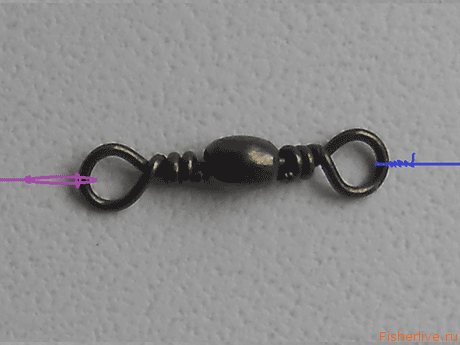
Many anglers ignore installing the swivel, supposedly it is very noticeable, and use regular loops. This is fundamentally wrong, since soon a twist will appear that will scare away the fish much more than a weightless swivel.
This is where I will end this article. If you have any questions, suggestions, or you just want to discuss something, write in the comments or in social network groups, although I am here much more often than in groups
